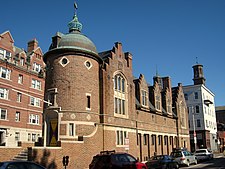
Harvard Lampoon Building
The Harvard Lampoon Building (sometimes referred to as the Lampoon Castle) is a historic building in Cambridge, Massachusetts, which is best known as the home of The Harvard Lampoon, and for its unusual design.
Location
Reception[edit]
Barrett Wendell once described the building as "sturdily honest as the founder who designed it, yet laughing at every turn with freakish gayety and beauty."[4] However, the building's architecture has been criticized, most notably by former Cambridge mayor Alfred Vellucci. He once described it as "one of the ugliest buildings in the world"[8] and claimed that "it does nothing but scare strangers"[9] and "looks like a witch on a broomstick."[10] He also noted that the location of the building "is an ideal spot for a restroom",[10] and once unsuccessfully proposed a city ordinance declaring the building a public urinal.[8]
The building was added to the National Register of Historic Places in 1978.[1]
Foliage[edit]
Vellucci later clashed with the Harvard Lampoon due to a tree that he planted on city land in front of the building in 1961 in order to block the view of the building.[8] He wished to obscure the face of the building because he found it ugly and to avenge local Italian Americans, whom he believed the Lampoon had insulted by claiming that an Irishman (rather than the Italian Christopher Columbus) discovered America.[10] Vellucci's opposition was also fueled in part by the proposal from members of the Harvard Lampoon to rename a nearby intersection "Lampoon Square",[9] and by the satirical portraits of Vellucci that they published.[8]
During the sixties, seventies, and eighties the tree was routinely vandalized, its branches often chopped off and acid was poured on the tree twice. However, in 1991 the tree was completely chopped down. The Harvard Lampoon refused to confirm or deny involvement in the event[11] and a smaller tree was planted in its place.[8] Three years later the tree was felled on the night of Harvard's commencement. The leadership of the Harvard Lampoon denied any complicity, and suggested that it may have been a false flag operation by members of the Harvard Crimson.[11]



